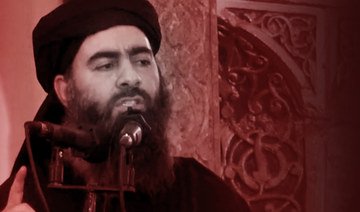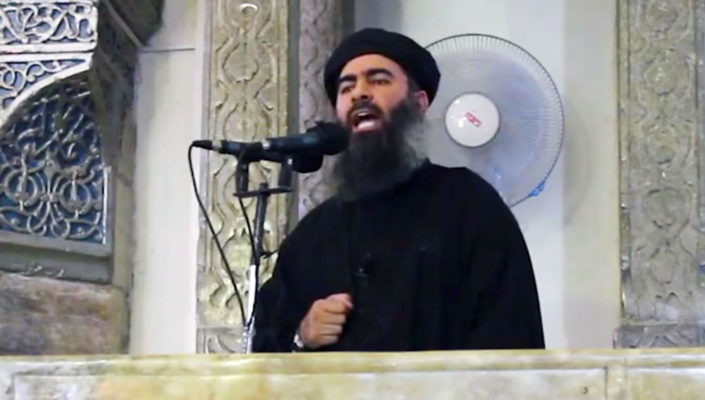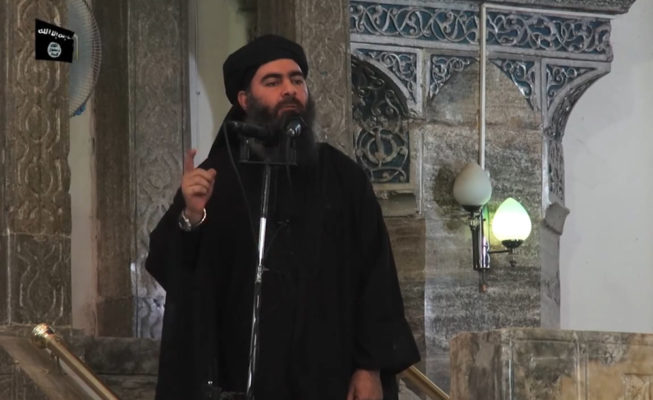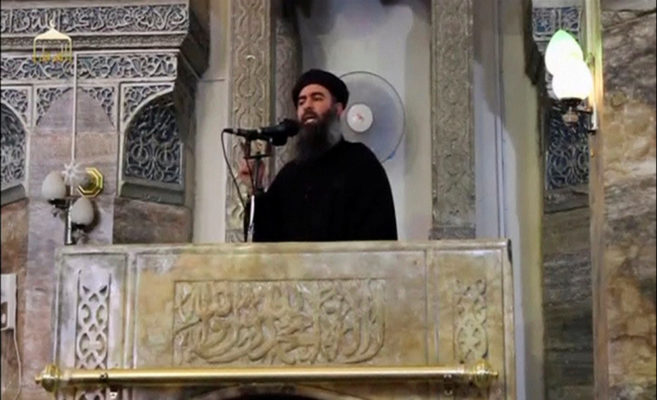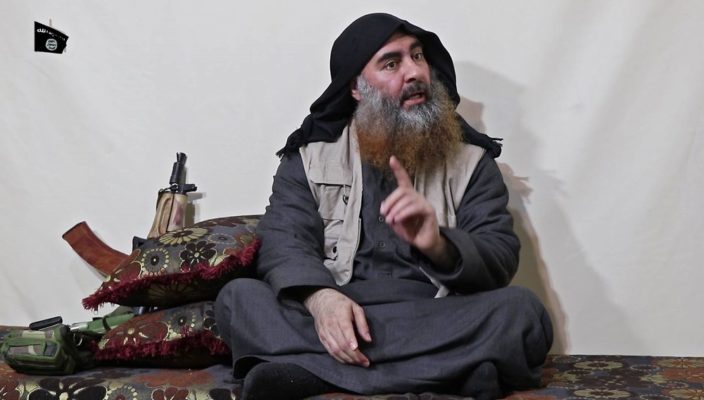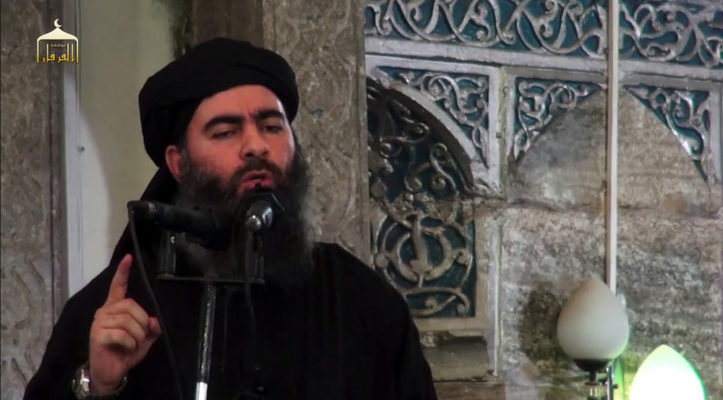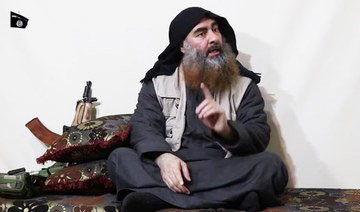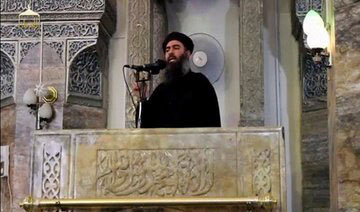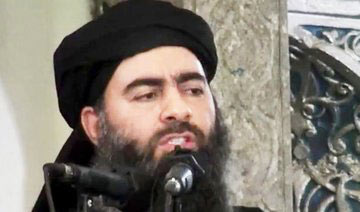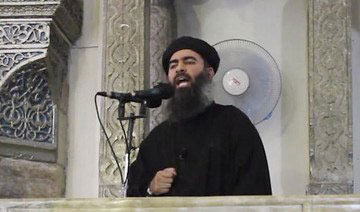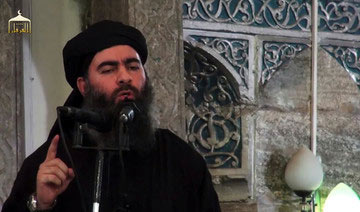Abu Bakr Al-Baghdadi
Nationality:
Iraqi
Place of Residence:
Unknown
Occupation:
Self-proclaimed leader of Daesh
Legal Status:
Committed suicide after US raid on October 27, 2019
Medium:
Video and audio sermons through Daesh’s media arm Al-Amaq news agency
Reports suggest that he attended the Islamic University of Baghdad, now known as Iraqi University, where he studied Islamic law and theology in the late 1990s. Afterwards he joined Salafist and terrorist groups in the country following the 2003 US invasion. He was later caught and detained with Al-Qaeda commanders, which is thought to be his first run-in with the group.
Baghdadi later joined the terrorist organization in Iraq and rose through its ranks until attaining the highest position of emir in 2010. Afterwards, the group reorganized and renamed itself the Islamic State in Iraq.
Although Al-Qaeda’s leader Ayman Al-Zawahiri told him otherwise, Baghdadi expanded his group into Syria and, in 2014, officially broke all ties with Al-Qaeda and declared himself the first caliph of the Islamic State (Daesh).
After an international coalition was formed to fight the war on Daesh, multiple rumors arose about Baghdadi’s death given his years-long disappearance, however nothing was confirmed.
On Oct. 27 last year the US announced that Baghdadi had killed himself after detonating a suicide vest during a raid in Syria’s Idlib province.
Analysis
- Far from a show of strength, the Daesh leader’s reappearance in a propaganda video is a sign of desperation, security analysts say
- Since he first declared the Daesh caliphate at Mosul’s central mosque July 4, 2014, Al-Baghdadi has been occasionally heard but never seen
Sitting cross-legged, the overweight man with a gray-streakedbeard spoke slowly and softly. Clad in quasi-military clothes, an AK-47assault rifle by his side, he could have passed for just another agingDaesh militant, spouting the hatred that has brought parts of the MiddleEast to its knees over the past five years.
But this was no ordinary paramilitary. The man in the video was the one who started it all: Ibrahim Awwad Ibrahim Al-Badri, who calls himself Abu Bakr Al-Baghdadi, self-proclaimed leader of the Daesh “caliphate” and the most wanted man on earth.
Since he first made that declaration at Mosul’s central mosque July 4,2014, Al-Baghdadi has been occasionally heard but never seen. Somethought him dead, or at least wounded, and certainly in hiding. Tounderstand why he would suddenly reappear in 18 minutes of propagandavideo after five years of invisibility, it is necessary to go back tothe beginning.
Al-Baghdadi was born in July 1971 in the Iraqi city of Samarra on theeast bank of the Tigris, 125 km north of Baghdad. He had relatives whoworked in Saddam Hussein’s feared intelligence service and army, whichhe was unable to join because of his nearsightedness.
An average student, he enrolled at the Saddam University for IslamicStudies. In the mid-1990s he joined the Muslim Brotherhood.Contemporaries say he left the organization around the turn of thecentury to mix with determined militants — a path many have followedsince.
Al-Baghdadi gained a master’s in Islamic studies and a PhD in Islamiclaws in 2000. He loved football, and lived in a small room adjacent tothe mosque.
His exact involvement in the insurgency and civil war that gripped Iraqafter the US invasion is disputed. He was arrested in Fallujah and heldat the infamous Camp Bucca detention camp from early 2004. The ideologythat fired Daesh dates back centuries, but its operational origins canbe traced to this prison in the mid-2000s. It mixed militants withformer Saddam military intelligence officers who together plotted thegroup’s eventual rise. Al-Baghdadi entered the prison as a mid-levelmilitant and left with enhanced connections and a reputation forreligious knowledge.
In 2002, an organization called Tawhid wal-Jihad began to operate innorthern Iraq, led by a Jordanian, Abu Musab Al-Zarqawi. Following the2003 invasion, Al-Zarqawi’s group grew and became part of Al-Qaeda in2004, under the banner Al-Qaeda in Iraq. Among its recruits wasAl-Baghdadi. He rose through the ranks as the US surge started in 2007and successive leaders were killed. Judged as having sufficientreligious authority, he was made leader in 2010.
In 2011, Al-Baghdadi created Jabhat Al-Nusra and said it would join theexpanded Islamic State of Iraq and Al-Sham (Daesh). The name isimportant — “Al-Sham”/Greater Syria evoked memories of previouscaliphates. After a dispute, the Al-Qaeda leadership disowned Daesh.
Under Al-Baghdadi’s leadership Daesh rapidly gained and held ground.Raqqa and Fallujah fell in early 2014, followed by Mosul. Daesh was nolonger a terrorist group, but an army with occupied territory.
On July 4, 2014, after the world had been shocked by the group’slightning military advances, Al-Baghdadi seized his moment with theaddress at Mosul’s central mosque in which he deliberately highlightedmannerisms and stylistic elements to evoke the style of previouscaliphs.
Before he spoke he used a miswak to clean his teeth in the traditionalway. He wore a black turban, and spoke classical Qur’anic Arabic,claiming to be implementing God’s law.
As the so-called “caliphate” established itself, Al-Baghdadi was alooming, if not visible, figure. Audio recordings were releasedintermittently. In the spring of 2015, he laid bare his twistedreligious views, saying Islam was never a peaceful religion but was “thereligion of fighting.”
In September 2017, Al-Baghdadi reiterated his call for global jihad,calling for “soldiers of Islam in every location to increase blow afterblow.”
Nevertheless, by February 2019, Daesh had been reduced to a bleakencampment in Baghouz, Syria, where the last remaining fighters werekilled or taken prisoner. Even before that, Iraqi security officialstold Arab News, many Daesh fighters and commanders “had become skepticalof Al-Baghdadi, and accused him of being lazy.”
However, tanks and bombs had failed to kill Al-Baghdadi himself, or hisgroup’s ideas. His new propaganda video was a wake-up call to theworld’s intelligence community, but it was addressed mainly to hisremaining followers.
“Al-Baghdadi was forced to appear at this time to respond to the chargesagainst him by other leaders of his organization, especially that heabandoned his fighters,” an Iraqi national security official andpsychological analyst told Arab News.
Another intelligence officer said: “There are real problems suffered bythe organization, especially after losing Baghouz. Al-Baghdadi wastrying to defend himself, and justify the loss of his fighters in Mosuland Sirte.
“He was denying the charges of cowardice and abandoning his fighters,and sought to give them new hope. These are psychological messages toraise their morale.
“The video clearly indicates the breakdown of confidence between Al-Baghdadi and his leaders.”
For those monitoring Daesh’s violence, it was a reminder that althoughthe group may no longer hold territory, it is still a global threat, ledby an ideologue who uses false religious justification to support itscrimes.



